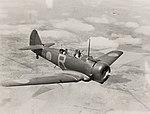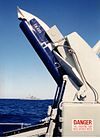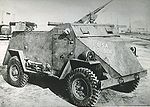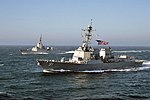Portal:Military history of Australia/Equipment
historical reference. . Either the page is no longer relevant or consensus on its purpose has become unclear. To revive discussion, seek broader input via a forum such as the village pump |
| Note: Entries here have not been added to this page since 2007. Therefore, some articles listed here have been selectively merged to Portal:Military history of Australia/Selected article, with the omission of some underdeveloped articles. However, this page should be retained for historical reference. |
Equipment 1
Portal:Military history of Australia/Equipment/1

The
Equipment 2
Portal:Military history of Australia/Equipment/2

The
Equipment 3
Portal:Military history of Australia/Equipment/3

The
Equipment 4
Portal:Military history of Australia/Equipment/4

The
Equipment 5
Portal:Military history of Australia/Equipment/5

The
Equipment 6
Portal:Military history of Australia/Equipment/6

The
Equipment 7
Portal:Military history of Australia/Equipment/7

The
Equipment 8
Portal:Military history of Australia/Equipment/8

The CAC Boomerang was an Australian-designed and manufactured fighter aircraft of World War II. Development of the Boomerang began in late 1941 following the start of the Pacific War and the first prototype flew on 29 May 1942. Boomerangs began to enter service with RAAF fighter squadrons from April 1943 but were not successful in this role due to the aircraft's mediocre performance. The Boomerang did, however, prove to be a successful close air support aircraft and saw action in New Guinea, the Solomon Islands and Borneo.
Equipment 9
Portal:Military history of Australia/Equipment/9

Equipment 10
Portal:Military history of Australia/Equipment/10

The
Equipment 11
Portal:Military history of Australia/Equipment/11

The
Equipment 12
Portal:Military history of Australia/Equipment/12

The
Equipment 13
Portal:Military history of Australia/Equipment/13

The
Equipment 14
Portal:Military history of Australia/Equipment/14

The
Equipment 15
Portal:Military history of Australia/Equipment/15

The
Equipment 16
Portal:Military history of Australia/Equipment/16

The
Equipment 17
Portal:Military history of Australia/Equipment/17

The
Equipment 18
Portal:Military history of Australia/Equipment/18

The
Equipment 19
Portal:Military history of Australia/Equipment/19

The
Equipment 20
Portal:Military history of Australia/Equipment/20

The Australian Light Armoured Vehicle (ASLAV), is an Australian version of the Mowag Piranha. It is a highly mobile, eight wheeled amphibious armoured vehicle used for reconnaissance and surveillance operations. The ASLAV has a range of 600 km with a top road speed of 100 km/h. ASLAVs have seen operational service with the Australian Army in East Timor, Afghanistan and Iraq.
Equipment 21
Equipment 22
Portal:Military history of Australia/Equipment/22

The
Equipment 23
Portal:Military history of Australia/Equipment/23

The
Equipment 24
Portal:Military history of Australia/Equipment/24

The
Equipment 25
Portal:Military history of Australia/Equipment/25

The
Equipment 26
Portal:Military history of Australia/Equipment/26

The
Equipment 27
Portal:Military history of Australia/Equipment/27

The
Equipment 28
Portal:Military history of Australia/Equipment/28

The CAC Wackett trainer was the first in house designed aircraft from the Commonwealth Aircraft Corporation of Australia. The name was derived from its designer Lawrence Wackett. It entered service in March 1941 with 200 being delivered to the Royal Australian Air Force by 1942. It was a tandem seat monoplane training aircraft of steel tube and fabric construction with a Warner Scarab radial engine and a Hamilton two bladed propeller.
Equipment 29
Portal:Military history of Australia/Equipment/29

The Bathurst-class corvettes were a class of minesweepers produced in Australia during World War II. 56 in total were commissioned by the Royal Australian Navy, and 4 by the Indian Navy. The Bathurst class ships performed a wide range of tasks during the war, including escorting convoys, sweeping minefields, hydrographic surveys, transporting troops and bombarding enemy positions. The ships displaced up to 1,025 tons and had a top speed of 15 knots.
Equipment 30
Portal:Military history of Australia/Equipment/30

Equipment 31
Portal:Military history of Australia/Equipment/31

The
Equipment 32
Portal:Military history of Australia/Equipment/32

The
Equipment 33
Portal:Military history of Australia/Equipment/33

The Attack-class patrol boats were small coastal defence vessels built for the Royal Australian Navy (RAN) and operated between 1967 and 1985. Twenty boats were ordered by the Department of Defence in 1965 at a cost of around $AUD 800,000 each from two Queensland shipyards, Evans Deakin in Brisbane and Walkers in Maryborough. The Attack-class ships had a displacement of 146 tons, a crew of up to 25 and were armed with a 40-mm gun, an 81-mm mortar and two 0.50 calibre machine guns. The Attack class was replaced in RAN service by the larger and more capable Fremantle-class patrol boats. Many Attack-class patrol boats were donated to the defence forces of Pacific nations.
Equipment 34
Portal:Military history of Australia/Equipment/34

The

